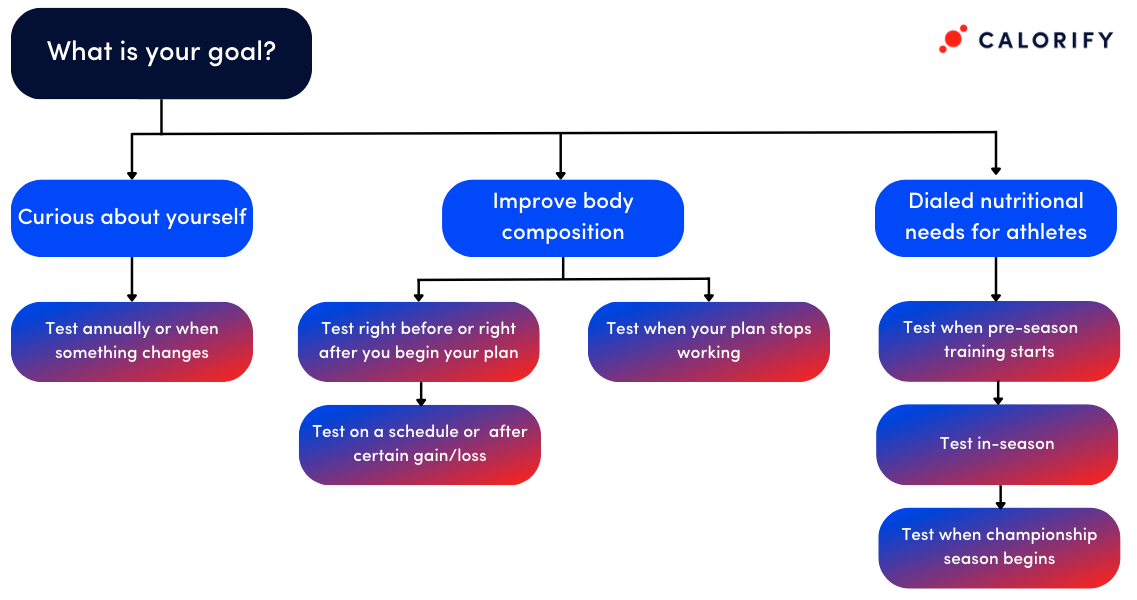When should I repeat test?
In order to really answer this question, we have to start with the question “What is your goal?”.
At Calorify, we know that no body burns the same, so everybody has different testing needs.
In this post, we’ll walk through three of the most common scenarios.
1. Curious about yourself
First is the person who is curious about how their body is working. That curiosity can range from someone who wants annual check-ins to the person who wants to know how their metabolism responds to specific lifestyle changes. Wherever you fall, no worries–just test again when something changes. Calorify is a bit like a credit score, it’ll change when something else changes substantially. Otherwise, it’ll stay pretty stable.
2. Improve body composition
The second scenario we see is the person who is looking to change their body composition (this normally means losing fat and/or gaining muscle). Losing fat and gaining muscle can end up being a seemingly impossible balancing act as it requires such a specific calorie deficit or surplus to meet your specific goal.
Calorify can provide those specific recommendations based on your goal weight, date, body composition, or a mix of the three. We can tell you where to start and what is sustainable.
For example, let’s say you’re trying to lose weight (trying to lose fat) and you’re about to start training or you’re a week or so into your new routine–now would be the perfect time to test. At this point we would see what your baseline burn is and would be able to point you in the right direction for what a sustainable calorie deficit would be.
Then once you’ve started training we want to make sure you stay on track.
We know that half of Americans try to lose weight each year, but many yo-yo in and out and have a hard time maintaining a stable weight. Maybe you start this new aggressive routine and it works for the first 10 pounds or so, but then you start to plateau. It’s incredibly frustrating, and we’re here to help prevent that.
So, a repeat test at the start of a plateau is a good idea because it’s an indication that your body’s needs have changed. These plateaus are also predictable and scheduling repeat tests can help you stay ahead of such plateaus. Maybe you test on a monthly or bi-monthly basis, maybe you test every 6 weeks–whatever interval, more regular tests during such targeted training will help you from getting stuck.
Or, if you don’t want to test on a schedule, just start training and really lean into the plateaus (test only when you start having issues). This approach works best if you have a more relaxed time goal and are okay with hitting a few plateaus. We know everyone has different goals, and we’ve watched people thrive with this approach.
Case Study: Common Weight Loss Plan
Let’s take an aggressive weight loss plan of about two pounds per week. If you stay on track for eight weeks, you’ll lose sixteen pounds. It was probably easier in the beginning, but as time goes on, it gets harder to lose that same two pounds a week. And this makes sense, because we know this weight loss relationship isn’t linear. As you get smaller, you get less lean body mass which means your basal metabolic rate goes down, meaning your overall metabolic rate goes down. If you used to be in a 1,000 calorie deficit in order to lose 2 pounds a week, perhaps an 850 calorie deficit is more appropriate now and you’ll be losing 1.6 pounds a week instead. It all depends on your individual goals, and we’re here to help you meet those goals while being real about the science along the way.
Case Study: Under Fueling
Let’s take someone else who has been chronically under fueling. Maybe they start at a new gym and start weight lifting, thinking this will help them get out of the rut they’ve been stuck in. They are wondering why they can’t meet their goals and decide to take a Calorify test. We would find that they have a low metabolic rate, burning something like 2,300 calories a day, despite their higher activity levels.
Should this person be cutting calories to reach their body composition goal? Not right away at least. We could recommend that they eat more (and more protein), build muscle (through resistance training), and this would effectively ‘boost’ their metabolism as they gain lean body mass. Once their metabolic rate increases, then we can switch back into lose-fat mode.
This type of bulking-cutting cycle is common in the strength training world because it’s far easier to achieve the gain muscle/lose fat goal in phases rather than all at once.
At Calorify, we would help you find the right amount to eat for a good bulk to gain lean mass. Then after tracking your progress, we can recommend the appropriate cut from the new place that you’ve built to.
3. Dialed nutritional needs for athletes
As an athlete, fueling appropriately is key to performance. Most athletes (across disciplines) have distinct, periodized training. Throughout these different periods, your caloric needs change.
Let’s use track & field here as an example. Over the summer, you’re running really high mileage at a very low intensity. Here you’re building a big base so you have the capability for miles and you can fine tune as the season progresses. Once you’re in season, you’re still running a lot, but you’re adding interval workouts and building intensity. By the end of the season, the championship part of the year, you’re not running many miles but you are going through intense training to remain really fresh for key competitions.
We’ve been working with NBA teams and see the same cycle of training for them. During the pre-season, they’re trying to build that base with two-a-day practices and little down time. Then they shift into their regular season–they play 82 games, they’re on the road, and they have a rhythm. Finally, they shift into the playoffs and championships which includes more rest. Overall, their needs change (as do most other athletes) based on what period of training they are in.
So how do you effectively test throughout these different periods? First, you’ll want to pick a week that will be accurate for the type of training you’ll be doing. It is important to test early in the new training period so that the data remains useful for the rest of that training period. Luckily, Calorify gets your test results back to you within two days of receiving your test. So, ideally, you would start testing in your first or second week of the new training period so that we can help get you on the right track.
We’ve tested rosters across disciplines and seen a key trend: even with the same training day-to-day, individuals are burning up to 1,000 calories above or below their teammates. We’ve seen training be totally sustainable for some while others completely fall off (just asking to get injured). This is all information that, until an injury occurs, coaches wouldn’t otherwise have.
To summarize, you aren’t the same athlete as your teammates, which is just one reason your team is so special. We’ll help you tap into that metabolic diversity and get the best performance out of you and your teammates.
Main takeaway?
These measurements are highly individual, and we’ll change when you change. Calorify will always be accurate, and you can optimize the Calorify test by picking a representative week. Let us help you figure out how your body is burning, and we’ll be here for all the changes along the way!




